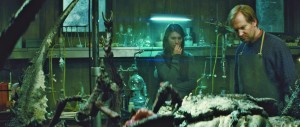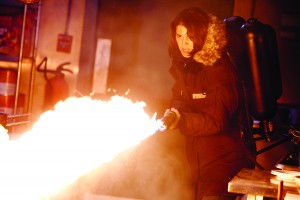A helicopter flies over the stark white Arctic landscape and, in the distance, a lone object cuts a path through the snow. I’m expecting a dog since that’s how John Carpenter‘s 1982 version of The Thing begins. But it’s not a dog and this isn’t a remake. In fact, it was the ’82 version that was a remake of 1951’s The Thing from Another World, widely regarded as a commentary on the Cold War. Likewise, Carpenter’s version is often credited with being a reflection of the AIDS epidemic, the major source of fear in the early ‘80s. So, one would expect this new version of The Thing to reflect current societal fears (terrorism, perhaps?). But this film doesn’t seem to take its legacy of social commentary very seriously and lacks the element of tapping into prevailing societal fear that the previous versions did so well.
However, this doesn’t mean that the film isn’t scary. It has its share of startling moments, and certainly capitalizes on the gross-out factor that modern special effects technology allows. The “thing” itself is a morphing mass of heads and limbs that attacks and kills in the most disturbing ways. It’s this ability to morph that is at the heart of The Thing. It’s the old Trojan Horse, sneaking into a base camp and attacking from the inside. Only this time, instead of Trojans, it’s aliens who crashed into Earth thousands of years ago only to be frozen in the Antarctic until a group of Norwegian researchers uncover the crash, along with a survivor frozen in a block of ice nearby.
The Norwegians recruit a team of scientists, including paleontologist Kate Lloyd (Mary Elizabeth Winstead), to unearth the alien being. The casting of a woman in the leading role is quite a departure from Carpenter’s version, which noticeably lacks women, which in itself is a departure from classic horror which has a habit of depending on women to be the helpless victims that need to be saved. Thankfully, Kate doesn’t need a man to save her and takes on a
leadership role in the group of men. The other woman in the cast doesn’t fare so well, but Kate manages to hold her own while still being realistically feminine, rather than have the mannish qualities of her predecessor in female sci-fi horror heroines, Ripley from the Alien films.
Shortly after Kate and the team dig up the “thing,” it disappears and preliminary research of its tissue reveals that it’s a replicator, allowing it to transform into identical versions of its victims, setting the scene of suspicion and distrust. The scientists realize that they’ve been infiltrated, but they don’t know who has been infected and everyone is a suspect, kind of like at the security checkpoint at the airport, but not really.
It is this element, along with the inherent isolation found in an Antarctic research station, that creates the underlying tension of the entire film. But the large cast diminishes the feeling of isolation and the quick succession of deaths fails to allow the audience to develop empathy for most of the characters, whose only purpose seems to be brutal onscreen deaths. I can’t remember the names of the characters or anything about them, but am left with several gruesome images in my memory.
Overall, the fun of the movie is recognizing the setup for the Carpenter version – an axe stuck in a wall, a charred two-headed corpse in the snow, and the bridge to the ’82 version, a lone dog running in the snow.
The Thing. Directed by Matthijs van Heijnengen. Starring Mary Elizabeth Winstead, Joel Edgerton and Ulrich Thomsen. Rated R. www.thethingmovie.net.
Review by Jennifer Waller Sibley



